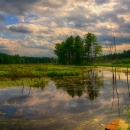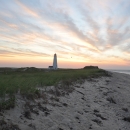About Us
Oxbow National Wildlife Refuge, is one of the eight refuges that make up the Eastern Massachusetts National Wildlife Refuge Complex. This land, consisting of fertile flood plain soils were historically first inhabited by indigenous peoples of the region, then followed by the colonists and then the U.S. Army. Starting in 1917 this area was a part of Camp Devens, later to become Fort Devens. In 1974 after various land transfers, the refuge land was given to the U.S. Fish and Wildlife Service from the Department of Defense.
Within its boundary is a diverse array of habitats beneficial to wildlife, including wetlands, forested uplands, old fields, oxbow ponds and of course the Nashua River. The U.S. Fish and Wildlife Service manage the refuge for an assortment of wildlife species, with special focus on migratory birds. Specifically, American woodcock and Massachusetts’s threaten Blanding’s turtle are important species for the refuge. Frequent residents of the refuge include white-tailed deer, fox, turkey, waterfowl, and various species of insects, amphibians, and reptiles.
Our Mission
Vision
The Eastern Massachusetts National Wildlife Refuge Complex will contribute to the mission of the Refuge System and support ecosystem–wide priority wildlife and natural communities. Management will maximize the diversity and abundance of fish and wildlife with emphasis on threatened and endangered species, migratory birds, and aquatic resources.
The Complex will have a well-funded and community supported acquisition program which contributes to wildlife conservation. The refuges will be well known nationally and appreciated in their communities. They will be seen as active partners in their communities, school systems, and environmental organizations which will result in high levels of support for the refuges.
The refuges will be a showcase for sound wildlife management techniques and will offer top-quality, compatible, wildlife dependent recreational activities. Refuges open to the public will provide staffed visitor contact facilities that are clean, attractive, and accessible, with effective environmental education and interpretation.
Refuge Purpose
Each unit of the National Wildlife Refuge System is established to serve a statutory purpose that targets the conservation of native species dependent on its lands and waters. All activities on those acres are reviewed for compatibility with this statutory purpose.
Oxbow National Wildlife Refuge purpose is its “…particular value in carrying out the national migratory bird management program.” (16 U.S.C. 667b-d, as amended)
Our History
5500 BC: First settlements of people of this area, based on archeological remains found. Presumably the Nipmuc Tribes, which were here when the British colonists arrive to this area.
1917: Camp Devens was established, later to become Fort Devens. The Fort was carved from the towns of Harvard, Lancaster, Ayer and Shirley.
1974: Oxbow National Wildlife Refuge is established after Department of Defense transfers land to the U.S. Fish and Wildlife Service.
2001: The Service acquired an additional 120 acres in the Town of Harvard adding to Oxbow National Wildlife Refuge.
Other Facilities in this Complex
Situated along the Atlantic Flyway in Massachusetts, the Eastern Massachusetts National Wildlife Refuge Complex is comprised of eight ecologically diverse refuges. The eight individual refuges include inland and coastal wetlands, forests, grasslands, and barrier beaches that provide important habitat for migratory birds, mammals, plants, reptiles and amphibians.
Complex headquarters is located at Assabet River National Wildlife Refuge, 680 Hudson Road, Sudbury, MA, 01776. Phone: (978) 443-4661.



